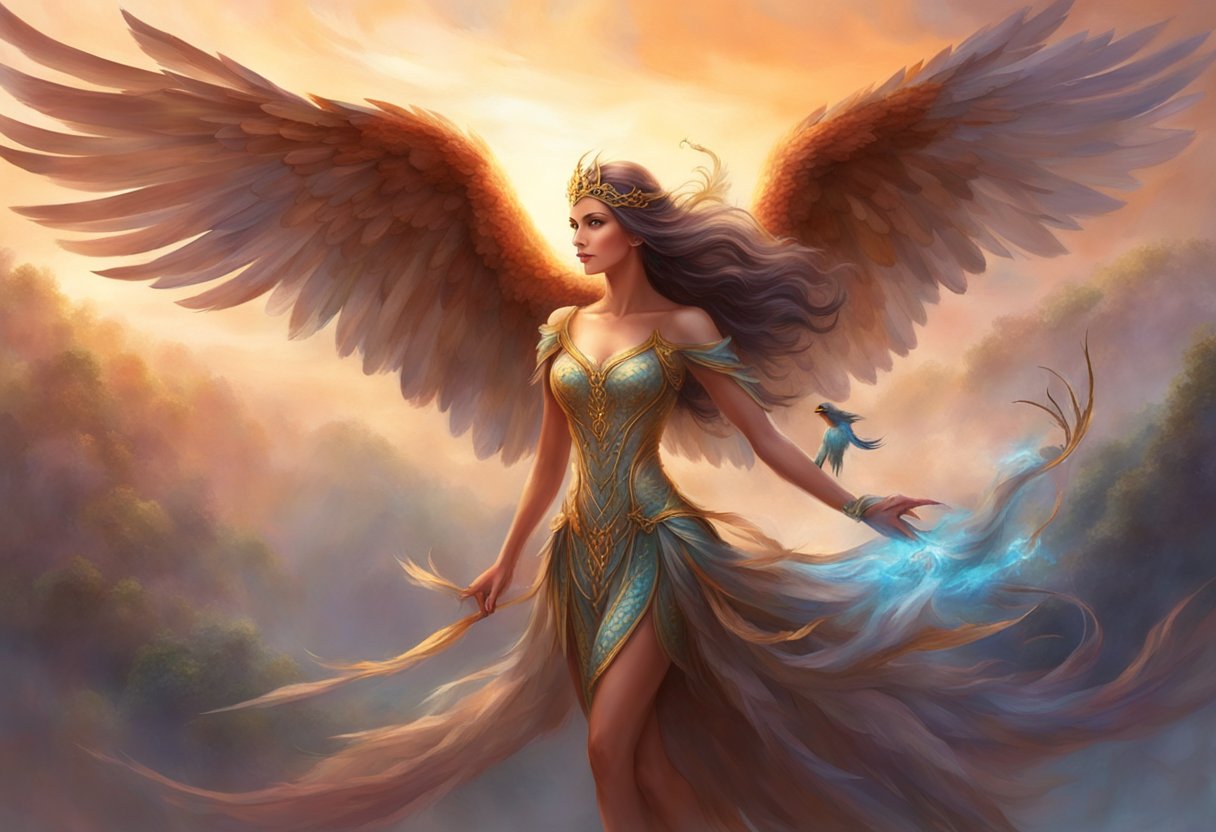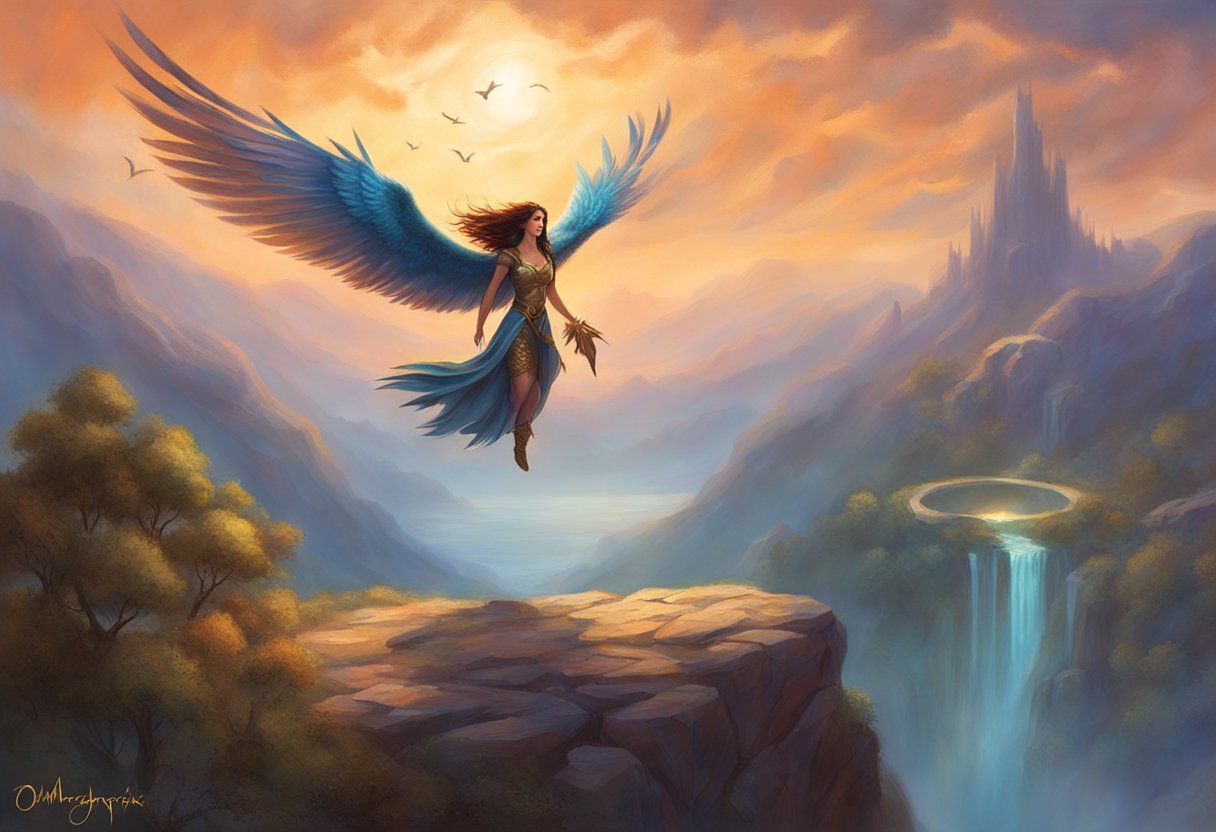Harpy is a mythical creature that has been a part of Greek mythology for centuries. It is a part-bird, part-woman monster that is known for its speed and agility. The name “harpy” comes from the Greek word “harpazein,” which means “to snatch,” an apt name for a creature that is known for carrying off anything from food to people.

The harpy’s roots can be traced back to the rich tapestry of Greek mythology, where they were first chronicled by writers such as Hesiod and Homer. According to Greek mythology, harpies were imagined as fair-locked and winged maidens who flew as fast as the wind. They were sometimes depicted as ghosts, and in Homer’s Odyssey, they were winds that carried people away. The presence of harpies as tomb figures also makes it possible that they were conceived of as ghosts.
Origins of the Harpy Myth

Ancient Greece
The Harpy is a mythical creature that originated from Ancient Greek mythology. The name Harpy comes from the Greek word “harpazein” which means “to snatch.” The Harpies were known to be winged creatures with the face of a woman and the body of a bird. They were often depicted as fierce and cruel, and their primary function was to carry off individuals and objects.
Literary References
The Harpies were mentioned in several literary works, including the Aeneid by Virgil and the Iliad by Homer. In the Aeneid, the Harpies were described as snatching the food from the table of the Thracian king Phineus, leaving behind an unpleasant smell. The sons of Boreas, Calais and Zetes, eventually rescued the king. In the Iliad, the Harpies were described as the “hounds of Zeus” and were sent out during storms to do his bidding.
Overall, the Harpy myth has been a prominent part of Greek mythology and literature for centuries. The creature’s origins and characteristics have been passed down through generations, and the Harpy remains an enduring symbol of power and fear in popular culture.
Physical Description and Attributes

Depictions in Art
Harpy, a creature from Greek mythology, is often depicted as a winged woman with a bird’s body, claws, and face. The wings are typically large and feathered, allowing the creature to fly at great speeds. The body is often muscular and toned, reflecting the creature’s strength and agility. The bird-like features are typically vulture-like, with sharp claws and a hooked beak.
In ancient Greek art, Harpies were often depicted as terrifying, bird-like monsters with sharp talons and wings. Some depictions even show them with the heads of women, with long, flowing hair and sharp teeth. Later depictions of Harpies in art show them as more human-like, with wings and bird-like features.
Symbolic Meanings
In mythology, Harpies were often seen as symbols of punishment and retribution. They were sent by the gods to punish those who had committed crimes or broken oaths. In this sense, they were seen as agents of divine justice, striking fear into the hearts of those who would dare to cross the gods.
Harpies were also seen as symbols of the destructive power of nature. They were often associated with storms and strong winds, which they were said to control. In this sense, they were seen as powerful and dangerous, capable of wreaking havoc on the world around them.
Overall, the Harpy is a fascinating creature with a rich history and many symbolic meanings. Whether seen as a symbol of punishment or a force of nature, the Harpy remains an important part of Greek mythology and a fascinating subject for artists and scholars alike.
Harpy Encounters in Mythology

Jason and the Argonauts
In Greek mythology, the Harpies were known as the “hounds of Zeus” and were often sent to punish mortals who angered the gods. One famous encounter with the Harpies occurred during the quest of Jason and the Argonauts for the Golden Fleece. The Harpies tormented the blind seer Phineus by stealing his food and leaving a foul stench in their wake. The Argonauts were able to drive the Harpies away by using the magic wind bag given to them by the god Aeolus.
Aeneas’ Journey
In Virgil’s epic poem, the Aeneid, the Harpies appear as a group of vicious creatures who torment the Trojans during their journey to Italy. They are led by the chief Harpy, Celaeno, who prophesies that the Trojans will face many hardships before they finally reach their destination. The Harpies are eventually driven away by the Trojan hero Aeneas and his men, who offer them a sacrifice of cattle to appease their hunger.
Overall, the Harpies were feared and respected creatures in Greek and Roman mythology, often serving as messengers of the gods or as symbols of divine retribution. Their appearance varied depending on the storyteller, but they were generally depicted as bird-like creatures with sharp talons and a fierce appetite for human flesh.
Cultural Impact and Legacy

Harpy in Popular Culture
The harpy has been a popular subject in various forms of media, including literature, film, and video games. In Greek mythology, harpies were often depicted as evil creatures that brought storms and destruction. However, in modern times, they have been portrayed in a more sympathetic light. For example, in the Percy Jackson book series, the character of Mrs. Dodds is revealed to be a harpy who is actually a loyal servant of the gods.
Modern Interpretations
In recent years, the harpy has been reimagined in a number of different ways. Some artists have depicted harpies as beautiful, seductive creatures, while others have portrayed them as fierce warriors or guardians. In popular culture, harpies have been used to represent a variety of themes, including freedom, power, and the struggle between good and evil.
One example of a modern interpretation of the harpy is the character of Mercy in the video game Overwatch. Mercy is a healer who has wings and is able to fly, much like a harpy. However, unlike traditional harpies, Mercy is depicted as a kind and compassionate character who uses her powers to help others.
Overall, the harpy has had a significant impact on popular culture and continues to be a source of inspiration for artists and writers today. Whether they are portrayed as evil monsters or heroic figures, harpies remain an enduring symbol of power and freedom.
Comparative Mythology

Similar Creatures in Other Cultures
The Harpy is a creature that is unique to Greek mythology, but there are similar creatures in other cultures as well. In Roman mythology, there is a creature called the Strix, which is similar to the Harpy in that it is a bird-like creature with a woman’s face. However, the Strix is associated with death and is said to feed on human flesh.
In Norse mythology, there is a creature called the Valkyrie, which is similar to the Harpy in that it is a female creature associated with death. However, the Valkyrie is not a bird-like creature; instead, it is a beautiful woman who chooses who will live and who will die in battle.
In Hindu mythology, there is a creature called the Gandharva, which is similar to the Harpy in that it is a winged creature. However, the Gandharva is not associated with death or destruction; instead, it is a celestial musician who is known for its beautiful singing voice.
Overall, while the Harpy is a unique creature in Greek mythology, there are similar creatures in other cultures that share some of its characteristics.
